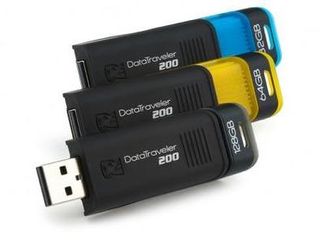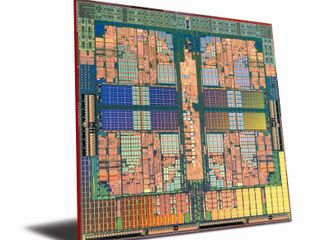Computing tech that defined the decade
From USB to multi-core, multi-touch and more
Where would we be without USB?
The USB 2.0 specification was introduced in 2000 and it's now had ten years to permeate through all aspects of computing and technology.

OVER TO 3.0: After ten years of Hi-Speed USB 2.0, the stage is set for the arrival of SuperSpeed USB 3.0
Hi-Speed USB has let us plug in all manner of peripherals including: external hard disk drives, flash drives, novelty USB desktop fans, digital cameras and camcorders, MP3 players, mobile phones, printers and scanners, keyboards and wireless dongles. Here's to USB 3.0, the next generation of plug-and-play connectivity. The less said about Wireless USB the better.
A decade of Wi-Fi
Can you remember what your life was like without wireless internet access? This decade has seen a boom in wireless networking technology, from the early adopters who played around with 802.11b and 802.11g (and the 802.11g+, Turbo and Super-G modifications) to the 802.11g MIMO-based technologies that would pave the way for today's 802.11n hardware. This decade also saw WiMAX (designated 802.16) promise a sci-fi landscape of city-wide wireless nodes. We're still waiting.
The impact of iTunes
Get daily insight, inspiration and deals in your inbox
Get the hottest deals available in your inbox plus news, reviews, opinion, analysis and more from the TechRadar team.
Gadget of the decade? Undoubtedly the iPod (and its many revisions and spin-offs, including the iPhone). But the iPod couldn't have changed the music landscape without Apple's iTunes software.

APPLE ITUNES: The Store continues to set the pace for digital downloads
Launched in 2001, the original version was a mere music manager for Apple's iconic digital music player. But come version 4 in 2003, the addition of an online iTunes Store sounded the first death knell for the traditional record shop. Fast forward to version 9 and iTunes is now a versatile (if clunky) gateway to downloadable music, videos, podcasts, movies, TV shows, Apps and audio books.
From single-core to multi-core
Up until 2004, processor technology was a straight speed race. The Pentium 4 kicked off the decade in 2000, incorporating Intel's 7th generation NetBurst microarchitecture. Clocked at 1.3GHz and 2GHz, the Pentium 4 was quickly scaled up to 3.8GHz in 2004 and incorporated HyperThreading, which acted as an extra (albeit virtual) processor core.

MULTI-CORE: Abandoning single-core processors in 2004, both AMD and Intel are now pursuing multi-core designs
But all this speed came at a cost – Pentium 4 chips ran hotter than any previous Intel chip with TDPs in excess of 100W. With the cancellation of the 4GHz Pentium 4 in 2004, Intel switched its attention to low-power processors (the Pentium M and Intel Atom) plus dual- and quad-core architectures. AMD beat Intel to the punch with both 64-bit processors and dual-core chips. Its dual-core Athlon 64 X2 processor was launched in 2005.
The age of 'touchy feely'
Anyone expecting the traditional QWERTY keyboard and mouse to have disappeared by 2010 will be sorely disappointed – they're still the most effective way to interact with a computer. Other gizmos have come and gone – the Maltron Single Handed Ergonomic Keyboard, Microsoft's Tablet PCs, Dragon Naturally Speaking and OCZ's brain-activated Neural Impulse Actuator to name only four.

MULTI-TOUCH: Microsoft's Surface prototype was unveiled in 2007 showcasing table-top multi-touch computing
Then there's 'multi-touch'... Touchscreens themselves have been around since the 1980s, but could only handle one contact point at a time. The Multi-touch concept gatecrashed the mainstream with the launch of the iPod touch and the iPhone in 2007. Microsoft also unveiled its Surface prototype in the same year.
From your desk to the Cloud
We already do a lot of our day-to-day computing in the so-called 'cloud'. We bank online, we shop online. We catch up with TV shows using the BBC iPlayer, store photos on Flickr and own virtual albums piped directly from iTunes or Amazon.

IPLAYER REVOLUTION: The BBC iPlayer (and rival services) have brought the PVR online, changing the way we watch television forever
Using a webmail service like Gmail or Yahoo! Mail we have access to our messages, regardless of whether we're using a Mac, a Windows PC, a Linux-powered netbook or a smartphone. This sort of device-independent, go-anywhere access to our important digital 'stuff' is arguably the future of personal computing.
You, me, Facebook and YouTube
If this digital decade is remembered for anything, it will be the rise (and rise) of social networking sites and Web 2.0 playthings. From Friendster to Myspace, Facebook and Bebo to Twitter and Posterous, there are now countless ways to update/spam/bore your friends with the minutiae of your daily life.
Similarly, this outgoing decade saw the launch of Web 2.0 giants like Wikipedia, Skype, Digg, YouTube, eHow, Gmail, Google Docs and Delicious. While online gaming will thank the noughties for a little title called World of Warcraft.
Goodbye to the noughties
It's not just computing technology that's changed during the past ten years. How we use our computers has also changed. We now Skype, Facebook and Twitter. We buy, sell, blog, make podcasts and upload home-made videos to YouTube. We work online, navigate, research and translate.
The computer hasn't quite made into into the living room with the TV, but it is starting to replace it. Catch-up TV services like the BBC iPlayer enable us to watch our favourite TV whenever and wherever we want to. While traditional Hi-Fi gear has been outmoded by digital playlists, MP3 players and wireless streaming.
Gates was right about a 'Digital Decade', but wrong about how strongly Microsoft would be involved in it.
As for the next decade of computing? We're bracing ourselves for faster, thinner laptops; more processor cores; USB 3.0; touchscreen interfaces; new Tablets and MIDs; faster internet access; wider mobile internet coverage; and maybe a new social network that will see the cool crowd abandon Facebook. Whatever happens, it's going to be exciting.
------------------------------------------------------------------------------------------------------
Liked this? Then check out Gaming smackdown: Windows XP vs Windows Vista vs Windows 7
Sign up for TechRadar's free Weird Week in Tech newsletter
Get the oddest tech stories of the week, plus the most popular news and reviews delivered straight to your inbox. Sign up at http://www.techradar.com/register
- 1
- 2
Current page: USB 2.0, Wi-Fi, multi-core and more
Prev Page Computing tech landmarks of the noughtiesMost Popular


